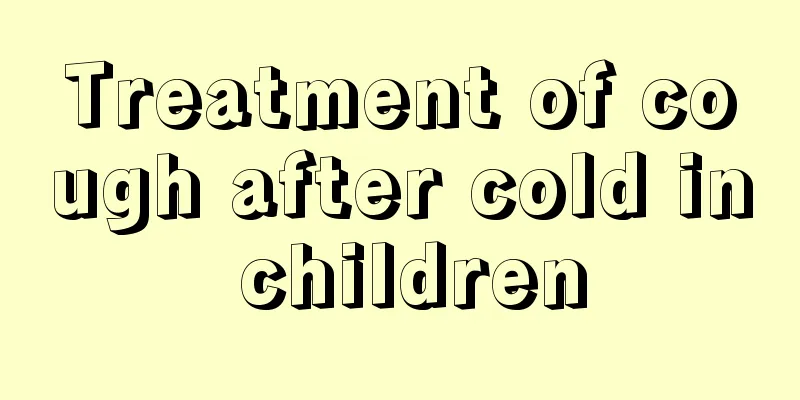Treatment of baby's cough and nosebleed

|
Nowadays, the incidence of baby coughing and nosebleeds is getting higher and higher. Recently, this disease has begun to wreak havoc. This disease causes great pain and torture to our children's bodies. For this reason, many parents are worried. They take their children to seek medical treatment everywhere, but their children's illness rarely improves. Moreover, over time, this disease will also lead to other diseases. So, is there any good treatment for baby coughing and runny nose? Let us now learn about the treatment methods for baby’s cough and nosebleed. Treatment: 1. General treatment First, comfort and calm the nervous and frightened patients and their families to prevent the patients' blood pressure from rising due to mental factors, which may aggravate the bleeding. Measure blood pressure and pulse in time, and give fluids when necessary to maintain stable vital signs. If the patient is in shock, first aid should be given to treat the shock. When inquiring about the medical history, the following situations should be inquired: which side of the nose is bleeding or which side of the nose bleeds first, the speed and amount of bleeding, whether there has been recurrent nosebleeds in the past, whether there is a cause for this bleeding, and whether there are other accompanying symptoms. 2. Find the bleeding point Depending on the specific situation, local nasal and systemic examinations are performed. When examining the nasal cavity, clear the blood clots in the nasal cavity, use 1% ephedrine and dicaine to fully shrink and anesthetize the nasal mucosa, and find the bleeding site as much as possible to stop the bleeding accurately. If conditions permit, it is best to find the bleeding point under nasal endoscopy and implement hemostatic treatment. 3. Methods of stopping bleeding in the nasal cavity Choose different hemostasis methods according to the severity, location, amount and cause of bleeding. (1) Finger pressure method: Patients can pinch both nostrils with their fingers or press the bleeding nostril against the nasal septum for 10 to 15 minutes. They can also press the upper lip horizontally with their fingers and apply cold compresses to the forehead and back of the neck at the same time. This method is suitable for patients with small amounts of bleeding and bleeding in the front of the nasal cavity. Patients can use this method when nosebleeds occur at home. (2) Local hemostatic drugs are suitable for milder anterior nasal bleeding. This method is simple and easy and causes less pain to the patient. For bleeding areas, you can use cotton pads soaked in 1% ephedrine, 1‰ epinephrine, 3% hydrogen peroxide solution or thrombin, and tightly plug the nasal cavity for several minutes to several hours to achieve the purpose of hemostasis. (3) Commonly used cautery methods include chemical cautery and physical cautery (including electric cautery, laser cautery and microwave cautery). For bleeding located in the anterior and inferior part of the nasal septum, the bleeding site can be clearly seen after the nasal mucosa has been fully contracted and anesthetized. You can use a cotton ball dipped in a small amount of 30% to 50% silver nitrate or 30% trichloroacetic acid to cauterize the bleeding point, and press on the bleeding point for a while until a white film is formed locally. (4) Anterior nasal packing can be used when there is severe active nasal bleeding or the bleeding site is unclear before surgery. The above content introduces us to the treatment methods for baby's cough and nosebleed. Through the above methods, we can have a deeper understanding of baby's cough and nosebleed. When our baby has cough and nosebleed, we can treat it in time and effectively. At the same time, it can also save us parents from troubles and allow more people to live a healthier and happier life. |
<<: What are the causes of small red spots on the hands of newborns?
>>: How to quickly stop your baby's cough
Recommend
Good way to care for premature babies born at 30 weeks
There are a lot of premature babies now, and thei...
How to treat vulvar inflammation in children?
Vulvitis is a common gynecological disease. Most ...
Diet therapy for children with green stool
Green stools are a common type of diarrhea in chi...
What are the developmental indicators of babies at 18 months old?
Families with children are more concerned about t...
What are the symptoms of pink eye?
Conjunctivitis is a common acute infectious eye d...
What are the reasons why children shake their heads?
At different stages of children's growth, chi...
What should I do if my 9-month-old baby has blisters on his feet?
If there is a baby at home, parents will be parti...
How many months old can a baby be held upright?
Many parents who become parents for the first tim...
Things to note when changing teeth
Children will change their teeth when they reach ...
What should I pay attention to when my baby coughs in summer?
In the summer, some babies will suddenly start co...
Do newborns need to be bathed every day?
Generally speaking, it is more appropriate to bat...
What to do if your baby has lip ulcers
Ulcers are a common disease among many people. Th...
What are the methods for children to eat bird's nest
Children’s physique is very fragile. From a tradi...
What to do if your child has roundworms in his stomach
It is normal for children to have roundworms in t...
What should I do if my child has high blood lipids?
Once the blood lipid level is very high, it will ...









